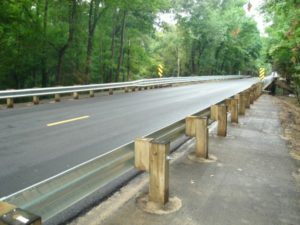CCA-Treated Guardrail Posts, Piles, and Poles – Good for the Environment and the Economy

Our highway and interstate system is a critical component of our nation’s infrastructure and economy. They are essential for the transportation of goods and services, emergency responders, commuting to work, and family vacations. It is imperative that our highways provide safe travel for all. Highway guardrails (see picture) are an important safety component of our highways. They typically consist of a galvanized metal rail, treated wood block, treated wood post, and fasters. However, steel blocks and posts can also be used.
Chromated copper arsenate (CCA) has a long history as an EPA approved wood preservative for numerous applications such as posts and blocks used in the guardrail assembly. Numerous independent studies have shown that CCA is an environmentally safe wood preservative and has very minimal leaching. Dr. Kenneth Brooks wrote in Pressure Treated Wooden Utility Poles and Our Environment that “pressure treated wood utility poles pose no greater risk to the environment than growing the wheat used to bake your next loaf of bread, and present far less personal risk than driving to your local grocery store to purchase that bread.” Similarly, Dr. Paul Morris has written “There are environmental risks associated with everything we do and with all of the material used to construct utility structures. For instance, the leaching of zinc from steel utility poles.”
The Treated Wood Council commissioned an independent study of the environmental impacts associated with the national production, use, and disposition of treated wood and galvanized steel highway guard rail posts using life cycle assessment (LCA) methodologies. The results for treated wood compared to galvanized steel guard rail posts were significant (© Treated Wood Council, 2013).
- Less Energy & Resource Use
Treated wood highway guard rail posts require less total energy and less fossil fuel than galvanized steel highway guard rail posts.
- Lower Environmental Impacts
Treated wood highway guard rail posts have lower environmental impacts than galvanized steel highway guard rail posts in five of six impact indicator categories assessed: anthropogenic greenhouse gas, total greenhouse gas, acid rain, ecotoxicity, and smog-causing emissions.
- Offsets Fossil Fuel Use
Reuse of treated wood highway guard rail posts for energy recovery will offset the use of fossil fuel energy and thereby reduce greenhouse gas levels in the atmosphere.
Bottom Line
CCA-treated wood is a critical part of our nation’s infrastructure and economy. It is safe for the environment and has a long history of EPA approval for both the environment and human exposure. The alternatives (steel and concrete) are not renewable and require more energy to produce than CCA-treated wood. Last but not least, CCA-treated wood is more cost effective than the alternatives. CCA-treated wood is good for the environment and the economy!
Meet the Author
Dr. Todd Shupe is the President of Wood Science Consulting, LLC. He is a well-recognized expert on wood forensics, wood preservation, wood decay and degradation, and wood species identification. He has a broad background in new product development, quality management, and marketing and sales in both the public and private sectors. For more information please visit DrToddShupe.com.
We welcome your comments below.
Thank you for visiting. We trust that you have enjoyed reading our articles.
Liked this post? Read more below or search for more topics . . .

